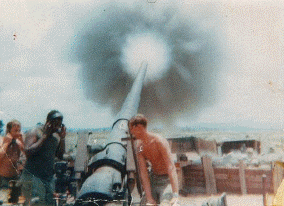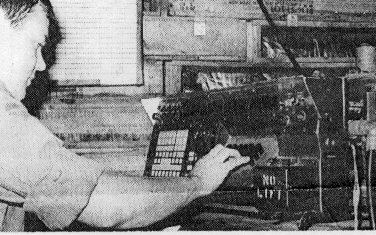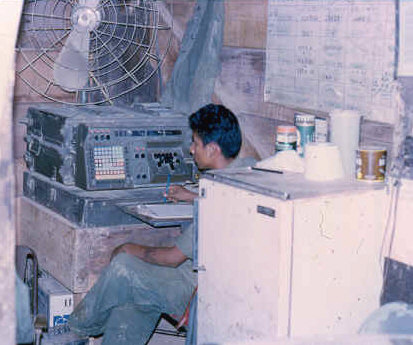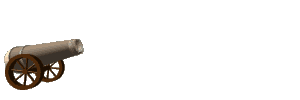Fire Mission
Written by: Tom Griffin,
7/15 FA Vietnam
Background recording compliments of Sgt James R. Claeys ("29er Charlie") Pleiku-An Khe (1969-70) 6/29 Arty & 2/11 Arty
These are the actual commands during an artillery Fire Mission:
"BATTERY ADJUST" (guns involved in the fire mission)"AZIMUTH 4800" (direction of fire the guns will be laid at)
"SHELL H.E." (high explosive shell)
"CHARGE 7" (powder charge necessary to reach target)
(Note: In this case the guns are 8-inch Howitzers since 175mm charges are classified as Zone 1, 2, or 3)
"FUSE QUICK" (point detonating)
"NUMBER TWO ONE ROUND, BATTERY ONE ROUND IN EFFECT" (method of fire. . . gun number two will begin to fire and make corrections until the desired result on the target is observed. At that time all the guns in the battery would fire on the target using Gun Number Two's corrected data)
"DEFLECTION 3210" (direction placed on the gunner’s Panoramic Telescope / moving the barrel, or tube of the gun, left or right in the desired direction toward the target)
"QUADRANT 648" (elevation placed on the Assistant Gunner's Range Quadrant / the tube is then raised or lowered until the desired elevation is reached)
"NUMBER TWO - FIRE!"

175mm
of the 7/15th firing near Kontum (Reprinted
from the February 25, 1971
Fire
Direction Center By 1LT Dennis Miller, OIC
FO / FDO School
NHA TRANG -- Within each firing
battery there is a mysterious bunker beneath a network of antennas. Its inhabitants,
although not unfriendly, are seldom seen and keep the lights burning all through the
night. Just what is this place? It is the battery's Fire Direction Center (FDC). The FDC seldom receives much
publicity. Pictures of it are of no comparison of those of the weapons in action. Although
there are not as many personnel as are on the guns, their function is almost as vital to
the effective application of artillery fire as is the ability of the weapons to hurl their
rounds thousands of meters to a target. FDC is essential Without the firing data provided by
the FDC, those rounds would seldom strike their intended targets, and artillery would
revert back to its former status when it was used only against targets which could be seen
from the guns. Through studies and tests carried
out over many years, the characteristics of the artillery weapons have been determined.
All this information has been compiled and reproduced in the form of tables, graphs, and
programs for a digital computer. That's right, a digital computer designated the Field
Artillery Digital Automatic Computer or FADAC (to its friends just "Freddie").
Each battery has its own FADAC and fires using the data computed by it. Charts, Maps. . . Tables and graphs and even FADAC are
not all the equipment utilized in the FDC. A map is required so that the altitude of the
target may be obtained. The exact location of the target with respect to the battery is
determined using the firing chart which has the battery located at its center and
graphically presents all the ground covered by the range of the weapon in 1000 meter
squares. From the firing chart the range and deflection from the battery to the target is
determined. All this equipment can be used to
determine data which will send the rounds toward the target, but some more information is
yet needed before really accurate fire can be obtained. How about the weather? Even an
eight-inch howitzer round is affected by the wind. The flight of the rounds is affected
also by the temperature, the density of the air and even the rotation of the earth. Additional Factors Other values which must be
considered by FDC are the temperature of the propellant and the weight of the round
itself. All these factors and others are considered when firing data is computed. The
FADAC can figure it all out within seconds and determine the data which will place the
rounds on target. Manual computations, using the
tables and graphs, take a little longer but must also be done in order to insure that
"Freddie" was given the right information. Also, FDC has to be able to do its
job even if the FADAC wasn't there. The personnel in the FDC represent
the duties which must be performed. Of course there must be a FADAC operator and someone
to work the chart, called the chart operator or more technically the vertical control
operator (VCO). Someone must talk to the outside world where the observer is so a
radio-telephone operator (RTO) is needed. In order to coordinate the actions
of the other personnel and to compile the data they determine, an individual called
"the computer" is required. Finally, activities of the FADAC operator, chart
operator, RTO and computer are checked by the Fire Direction Officer (FDO) who is in
charge of the FDC. Since the FDC is a 24-hour
operation, there must be two shifts thus identifying all those people who live and work in
the now less mysterious bunker beneath the network of antennas. A Fire Direction Center specialist
prepares to feed target information into the Field Artillery Digital Automatic Computer
(FADAC). Within seconds, firing data will be displayed on the computer, which has been
named "Freddie" by redleg operators
(Left to right: Eagle, Collins, Basso)
Photo credit: John James Basso
ARTILLERY REVIEW newspaper)
Depends On 'Freddie'

Fernandez working 'Freddie' with
a fan and fridge nearby at
FSB Veghel
Photo: Don Aird

